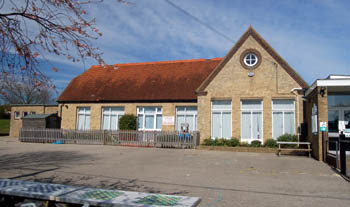
Stanbridge Lower School March 2008, the original 1881 building
A School Board was formed for the three parishes and the first elections were on 14th December 1874. The first meeting, at the Five Bells public house, was on 7th January 1875 and those present were: Rev.Thomas Green, the vicar, J.Franklin, J.Cook and F.G.Batchelor [SB39/11], At the second meeting on 24th February, it was agreed that schools should be built in Eggington and Stanbridge, the latter school to serve both Stanbridge and Tilsworth and "that the site be on the North East of the Bridleway leading from Stanbridge to Hockliffe". Unfortunately, on 21st April the Board met to hear that the land's owner, Thomas Eames, had refused to sell. The Board then approached Colonel Gilpin, Thomas Eames, Richard Littleboy, J.Mead, Miss Buckmaster and David Tims to see if any of them would sell or donate land. All of them refused. The trustees of Stanbridge Recreation Ground were then approached. They, too, refused. It was, therefore, proposed by the Vicar on 1st December that year to compulsorily acquire a piece of Bury Field. None of the other members agreed and instead the Tilsworth Estate was approached to grant a site in Vicars Meadow, close to the parish boundary. This also came to nothing.
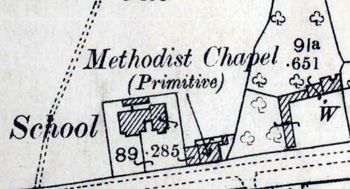
The Primitive Methodist chapel in 1901 also showing the school and Mere Cotatge to the east
On 5th January 1876 the trustees of the Primitive Methodist chapel in Tilsworth were approached to rent their school room as a temporary school. They agreed, subject to a rent of £10 per annum. The Board then approached the British and Foreign Schools Society for a mistress to teach about 60 children, no boys older than ten years. On 11th May 1876 the Board decided to issue a precept of 3 pence in the pound on rateable properties in the three parishes to support the Board and its work. On 20th May that year use of the Primitive Methodist schoolroom as a temporary school was finally approved and the first schoolmistress, Miss S.A.Collins, was appointed on 22nd June 1876. The school, the first proper day school in Stanbridge, was opened on Monday 26th June 1876 [see below for events in 1954].
Another four years passed and still no site for a permanent school in Stanbridge could be found. Finally the Department of Education, in exasperation, took the unusual step of dismissing the Board. In 1884, once Stanbridge Board School had been built, the District was again allowed to return to a School Board elected by its own ratepayers. In 1881 land for the school had been conveyed to the School Board by Richard Littleboy for £125 [SB39/2] and the new school finally opened in late 1881, the headmistress was Miss E.Trafford of 49 Wellington Street, Leek [Staffordshire], aged 28.
A land mark Education Act was passed in 1902, coming into effect in 1903. It disbanded the School Boards and gave day to day running of education to newly formed Local Education Authorities, usually the county council, as in Bedfordshire. The old Board Schools thus became Council Schools whilst the old National, British and other non-Board schools became known as Public Elementary Schools.
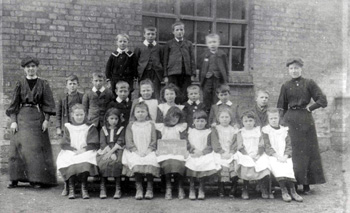
Stanbridge infants' class about 1910 [Z50/108/5]
Bedfordshire & Luton Archives & Records Service has a scrapbook of cuttings of visits made to most Bedfordshire Schools by School Inspectors for a period from just before the First World War through the inter-war years [E/IN1/1]. The first report on Stanbridge Council School in the volume dates to 1910: "The general level of efficiency in this school is fairly satisfactory on the whole, but arithmetic throughout is weak. The organisation does not provide for a systematic revision of back work and the result is that the children have already forgotten much that they learnt last year. Physical Exercise do [sic] not appear to have received sufficient attention. The schoolroom is untidy. No attempt is made to brighten it by pictures and flowers, and the walls are disfigured by old dilapidated maps which should give place to good modern ones. The Infants' Class is in good order and is making good progress".
The inspector returned two years later, average attendance was 91: "Some improvement has been effected in this School since it was last reported upon. An attempt has been made to remedy the weaknesses to which attention was drawn in the last report. I trust this improvement will be maintained and that the School will eventually take its place among the really satisfactory Schools in the area…The Infant's Class is brightly and well taught and the little ones make good progress".
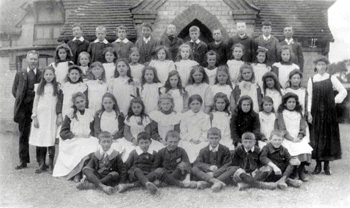
Stanbridge junior class about 1910 [Z50/108/6]
The next report in the volume is not until 1920, when average attendance had fallen to 68. After giving a luke-warm assessment of the various subjects taught the inspector concluded: "The work is to be discounted to a certain extent by the consideration that a number of the children in the middle part of the School are too old for the divisions in which they are placed…The condition of the Infant's Department is fairly satisfactory". In 1923 the inspector commented: "The present Head Teacher took charge of the school less than a year ago, when both the work and the discipline were anything but satisfactory. The progress which has been made is very remarkable. To give details is quite unnecessary, for there is no branch of the work which is not markedly improved, and in certain subjects it would do credit to any school. The children's attitude to their work and the fact that so much has been achieved in so short a time give reason to anticipate that the School will soon become one of unusual merit. The tone and discipline have improved no less remarkably than the work".
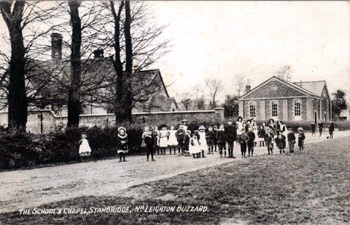
Stanbridge Council School and Primitive Methodist chapel about 1910 [Z1306/108]
Following a reasonably satisfactory, if brief, report on the infants department in 1926, two years later, with average attendance now 57, the inspector remained fairly impressed with the school as a whole: "In this school the Infants' section is now under a young Teacher whose manner and attitude to the children is unusually good. This section is very promising. The juniors are doing some quite average work: the Teacher here is handicapped by deafness, but apart from the Reading lesson in which mistakes are passed over, the oral lessons were brightly conducted and the children were very receptive. In the upper division, a higher standard of work in Arithmetic is still necessary. Otherwise the work is satisfactory, and, with some changes in method in certain subjects which were discussed, should become good. The general tone is very pleasing".
In 1931 the inspector noted: "In this Junior School, a good beginning is made in the infants' room and the work of the teacher of the next class is also good: this year, however, she is likely to have a difficult task as there are several backward children. The top class has materially improved…It is hoped that the Head Mistress;s own hard work will be rewarded by real excellence in some subjects before long". The final visit in the book took place in 1934, when average attendance was 57: "This Junior School is excellent in its work and attitude towards work in the top classes. Speech is clear and well connected, and the practice of delivering recitations from a small stage has had a very good effect. Writing and Arithmetic are clean and well set out. Drawing is also good. The examinations are suitable and well conducted. In the Infants' room the teacher has not yet got the power of managing several groups, and, as her experience has been mainly with the youngest children the older infants are not very far advanced. The speech here wants much attention. The school was seen at some disadvantage as a teacher was absent. The older children, working by themselves, were getting on with it very well indeed; but a small backward section of Standard I, who had to go into the Infants' classroom, perhaps emphasised the weakness in management of that teacher. The Head Mistress may be congratulated on the work and manners of the children in the upper classes".
The third of the great Education Acts was that of 1944 which established the principle of County Primary Schools for children up to the age of 11, at which time they took an examination to determine the nature of the secondary school they would attend, the most academically able going to grammar schools, the rest to secondary or secondary modern schools. Stanbridge Council School was duly renamed Stanbridge County Primary School.
In 1954 the wheel came full circle. In that year the owners of the defunct primitive Methodist chapel sold it to Bedfordshire County Council for £125 [CCE1035/4]. This was because the old chapel premises adjoined the eastern boundary of Stanbridge County Primary School. The chapel lay right on the road and was soon demolished and the cleared site used to extend the school buildings and site to the east. At the same time the existing school buildings were remodelled, as can be seen in the photograph of about 1910 above and that of 2008 below.
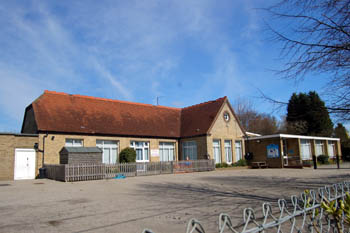
Stanbridge Lower School March 2008 - the newer buildings on the right are on the site of the Primitive Methodist chapel
In the 1970s Bedfordshire County Council introduced comprehensive education, doing away with the 11+ examination and grammar schools and introducing a tier of school between the old County Primary and County Secondary Schools. Thus Lower Schools now taught children aged 4 to 9, Middle Schools from 9 to 13 and Upper Schools from 13 onwards. Stanbridge County Primary School this became Stanbridge Lower School. Bedfordshire was abolished on 1st April 2009. The new Local Education Authority for Stanbridge was Central Bedfordshire Council, an amalgamation of the old Mid Bedfordshire and South Bedfordshire District Councils with the additional powers of the defunct Bedfordshire County Council.